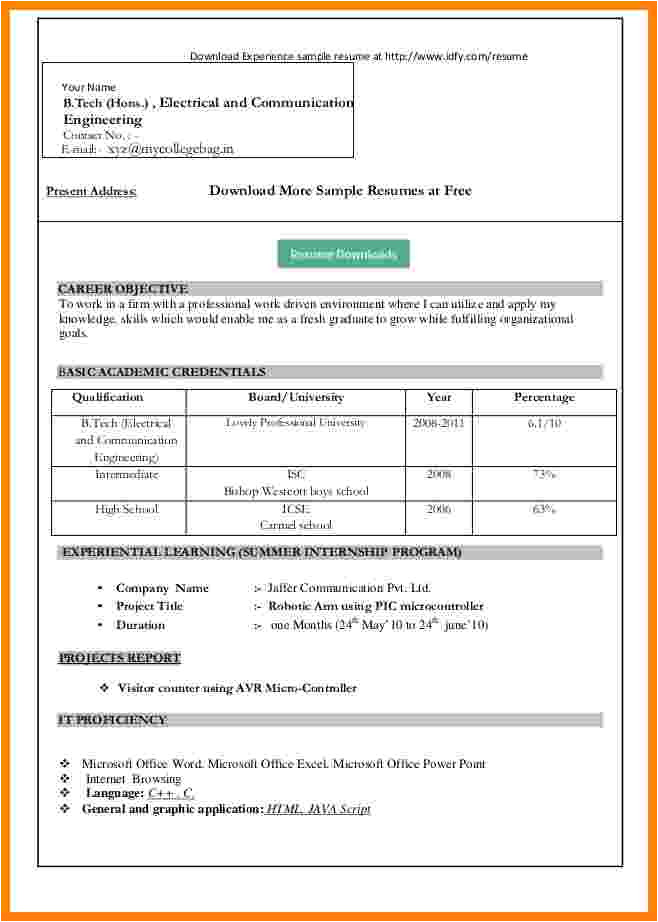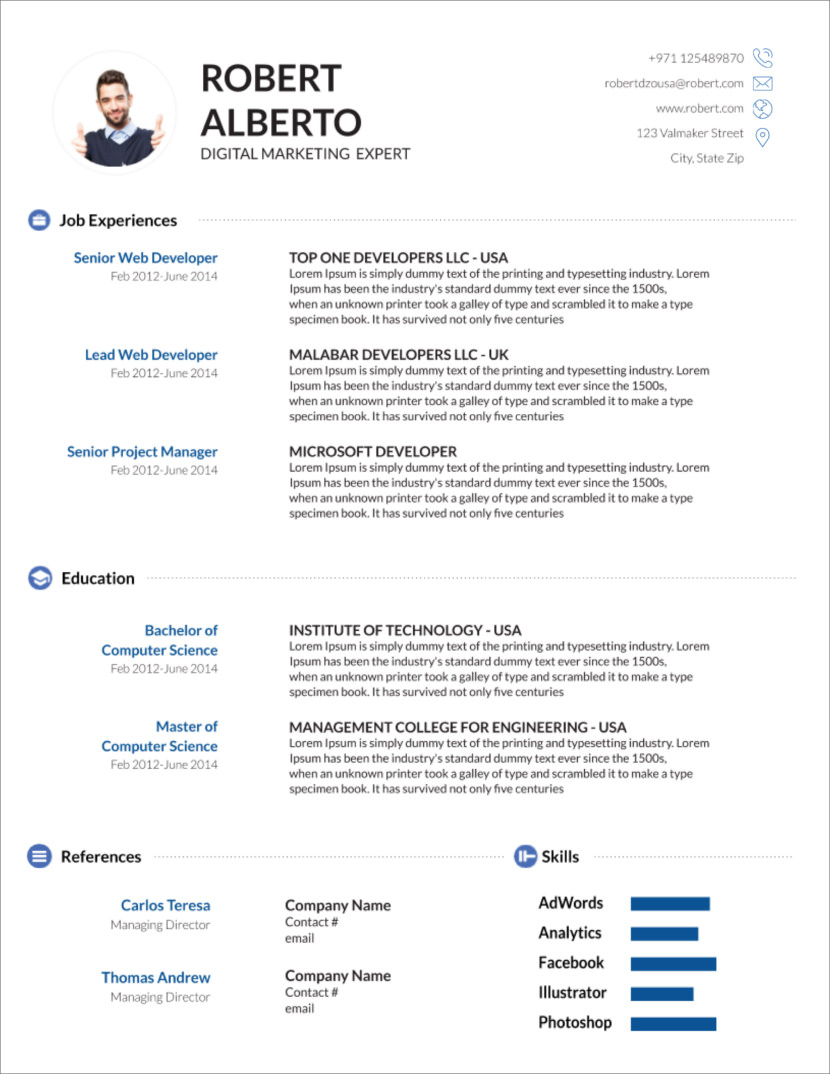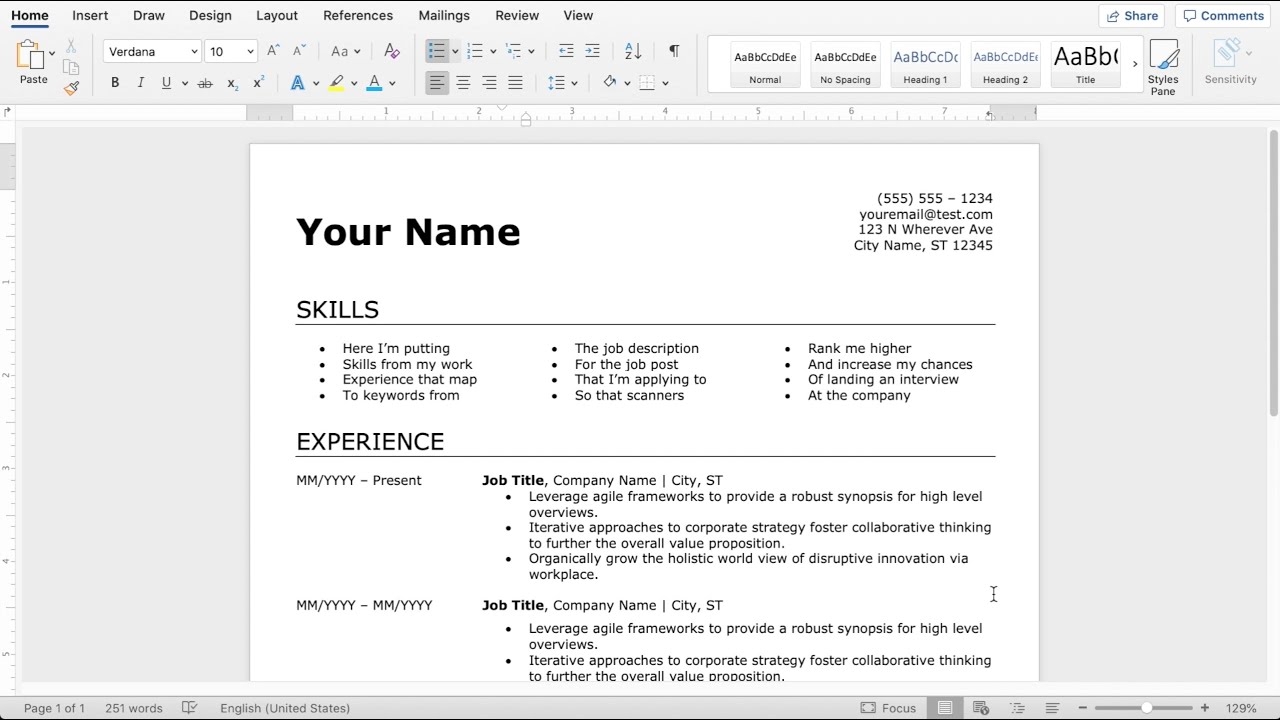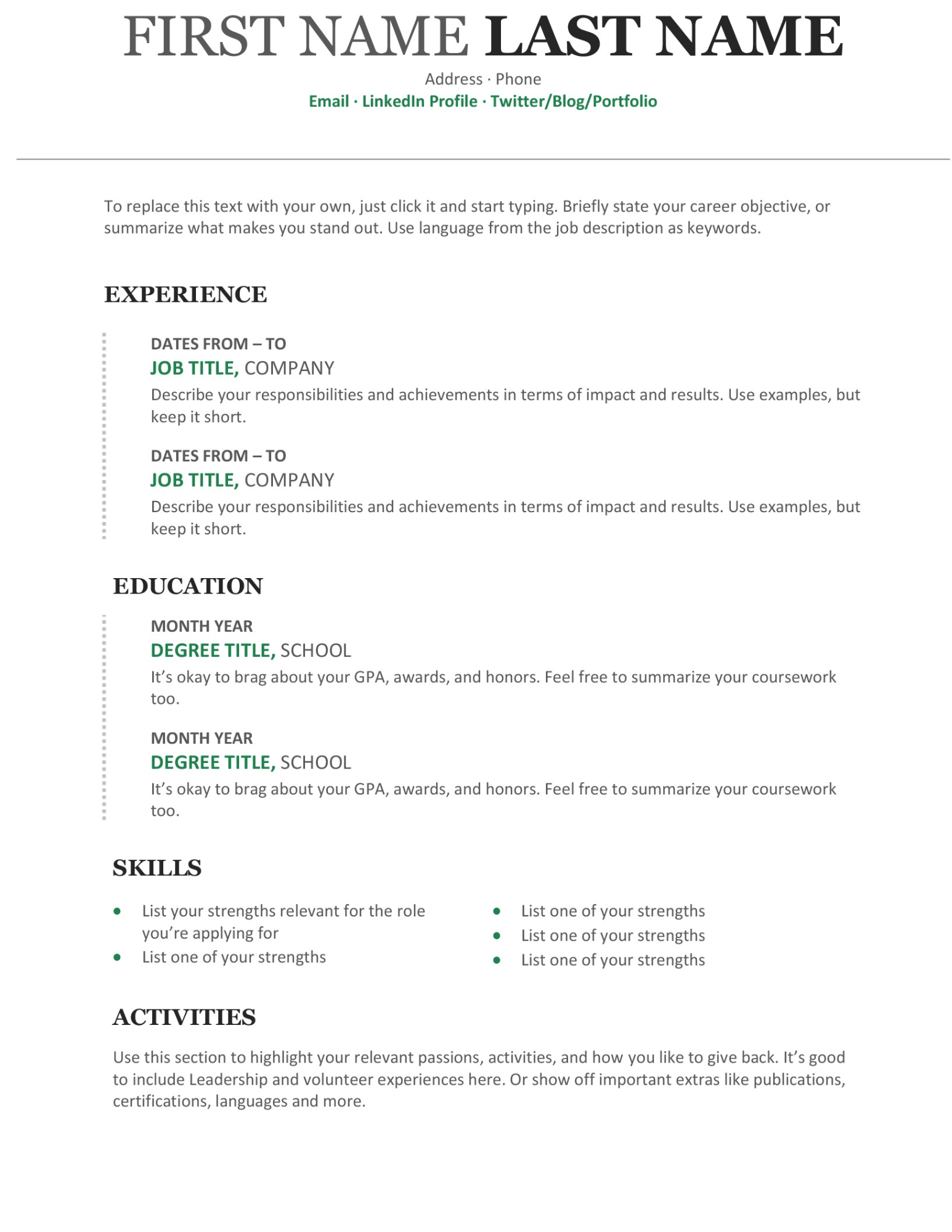Creating a CV can feel like a daunting task, especially if it's your first time. But don’t worry! With the right guidance and tools, you can craft a document that effectively showcases your skills and experience. Today, we’ll explore how you can create a professional CV using Microsoft Word 2007. With some handy tips from Dailymotion’s Career Tips, you’ll be on your way to impressing potential employers in no time!
Understanding the Basics of a CV

Let’s dive into the essentials! A CV (Curriculum Vitae) is essentially a comprehensive document that outlines your educational background, work experience, skills, and other qualifications. It’s your opportunity to make a positive first impression, and understanding its basic components is key.
Here are some fundamental parts you should include in your CV:
- Contact Information: Your name, phone number, and email address. Make sure this is easy to find!
- Objective Statement: A brief statement summarizing your career goals and what you hope to achieve in your next position.
- Education: List your educational history, starting with the most recent. Include degrees, institutions attended, and graduation dates.
- Work Experience: Detail your work history, including the job title, company name, dates employed, and a summary of your responsibilities and achievements.
- Skills: Highlight relevant skills that align with the job you are applying for, whether they are technical skills or soft skills.
- Certifications and Awards: Any relevant certifications or awards that add to your qualifications.
When crafting a CV in Microsoft Word 2007, keep formatting consistent and clean. Use bullet points for easy readability, and don't forget to proofread before sending it out to potential employers. A well-organized CV not only makes you stand out but can also give you an edge in the competitive job market!
Also Read This: Ultimate Guide to Crafting Delicious Vegetable Spaghetti with Dailymotion Video Tips
Setting Up Microsoft Word 2007 for Your CV

Getting started with Microsoft Word 2007 for your CV is a simple process, but it's crucial to set it up correctly to ensure your document is professional and polished. Follow these easy steps to get your workspace ready:
- Open Microsoft Word 2007: Click the Word icon on your desktop or in your start menu. You’ll be greeted by the program’s well-known interface.
- Create a New Document: From the main menu, click on the circular Office button at the top left. Select 'New' to open a menu where you can choose a blank document or a template.
- Set Page Margins: It’s essential to have appropriate margins for your CV. Navigate to the 'Page Layout' tab and click on 'Margins.' A standard 1-inch margin is a good choice.
- Choose the Right Font: Select a professional font like Arial, Times New Roman, or Calibri. To change the font, highlight the text and choose your preferred font from the home tab.
- Adjust Font Size: The ideal font size for a CV is between 10-12 points for the body text. Ensure your headings are a bit larger to grab attention!
- Set Line Spacing: Keeping your document readable is crucial. Go to the 'Paragraph' section in the 'Home' tab and select 1.15 or 1.5 line spacing for clear readability.
Once you've completed these steps, your document is ready for the next stages. With everything set up, you can focus on crafting your experience into a compelling CV!
Also Read This: How to Make Beautiful Nails: DIY Nail Art on Dailymotion
Selecting a Template

Templates can be a game-changer when it comes to creating a CV. They guide you through layout decisions and can save you a lot of time. In Microsoft Word 2007, you have various options for templates, which can help your CV stand out. Here’s how to select one:
- Access the Template Gallery: When you open a new document, click on the 'New' button from the Office button menu. You’ll see a 'Templates' section where you can find a range of options.
- Search for CV Templates: In the template search bar, type keywords like “Resume” or “CV." This will display a list of professional-looking templates designed specifically for resumes.
- Preview Templates: Hover over any template that catches your eye. Click on it to see a preview. This helps you visualize how your information will be organized.
- Choose a Template: Once you’ve found a template that fits your style, click on it and select 'Download' or 'Create.' It will open in a new document for you to customize.
- Customize the Template: Replace the placeholder text with your personal information. Remember to maintain uniform font sizes and styles across sections for consistency.
With the right template selected, it can boost your confidence as you fill in your details. A good template serves not just as a framework but as a tool to express your personality and professionalism!
Also Read This: How to View Removed Content on Dailymotion: Find Deleted Videos and More
5. Customizing Your CV

Creating a standout CV is all about customization. You want to ensure that your document reflects not only your personal style but also aligns with the job you're applying for. Here are some tips on how to make your CV truly yours:
- Choose a Template: Microsoft Word 2007 offers a variety of CV templates. Start by selecting one that suits your aesthetic and professional vibe. You can find these templates under the "New Document" option.
- Personal Branding: Use consistent colors, fonts, and styles throughout your CV. This helps in creating a professional brand image. Remember, less is often more!
- Tailor Your Content: Modify your CV for each application. Focus on experience and skills that are relevant to the particular job. Use keywords from the job description to increase your chances of getting noticed.
- Highlight Achievements: Instead of just listing responsibilities, showcase your accomplishments. Use quantifiable metrics to highlight your contributions, such as “increased sales by 20% over six months.”
- Utilize Sections: Don't shy away from reordering sections based on relevance. For instance, if you're a recent graduate, lead with your education before your work experience.
Remember, your CV is like a first impression—make it count!
Also Read This: How to Make Electricity from Water Easy Tutorial on Dailymotion
6. Essential Sections to Include
When it comes to your CV, ensuring you include key sections is crucial for catching the eye of potential employers. Here’s a breakdown of essential sections you should consider:
| Section | Description |
|---|---|
| Contact Information | Your name, phone number, email, and LinkedIn profile, if applicable. Make it easy for employers to reach you! |
| Objective Statement | A brief overview of your career goals and what you hope to achieve in the role you’re applying for. |
| Work Experience | A chronologically listed section detailing your previous jobs, responsibilities, and accomplishments. |
| Education | A section highlighting your academic qualifications, including degrees earned and institutions attended. |
| Skills | A list of relevant skills that you possess which are pertinent to the job, such as software proficiencies or language abilities. |
| References | Optional. You can note "References available upon request,” or list them if specifically required. |
By including these essential sections, you’ll ensure your CV is comprehensive and inviting to potential employers. Don’t forget to keep it clear and concise!
Also Read This: Using IDM to Download Dailymotion Videos with Ease
Formatting Tips for a Professional Look
When creating a CV in Microsoft Word 2007, the way you format your document can significantly impact how it's perceived by potential employers. A well-structured and polished CV showcases not only your qualifications but also your attention to detail. Here are some essential formatting tips to help you achieve that professional look:
- Choose a Clean Font: Stick to professional fonts like Arial, Calibri, or Times New Roman. Keep the font size between 10 to 12 points for body text and slightly larger for headings.
- Utilize White Space: Don’t cram your CV with too much information. Use spacing effectively to make it easy to read. Aim for margins of at least 1 inch on all sides.
- Consistent Formatting: Ensure that headings, bullet points, and text align similarly throughout the document. For instance, if you bold one job title, all job titles should be bolded.
- Bullet Points for Clarity: Use bullet points to list your achievements and responsibilities. This format makes your CV easier to scan and highlights key information.
- Use Sections Wisely: Divide your CV into clear sections such as Education, Experience, Skills, and References. Use headings and subheadings to draw attention to each section.
- Color Schemes: If you wish to use color, opt for subtle and professional hues. Stick to darker shades for text, and use color sparingly to highlight key areas.
By following these tips, you're not just creating a CV; you're crafting a document that professionally represents you and your career journey.
Also Read This: How to Use Skype on Computer: Make Video Calls and Stay Connected
Saving and Exporting Your CV
Once you’ve poured your heart and soul into crafting your CV, it’s crucial to save and export it correctly. This ensures that your potential employer views it just as you intended. Here’s a straightforward guide to saving and exporting your CV in Microsoft Word 2007:
- Save Your Document: Click on the “Office” button in the top left corner, then select “Save As.” Choose a location on your computer where you can easily find it later. Give your document a clear name, like “YourName_CV.doc.”
- Regular Updates: Remember to save your progress regularly as you work. Pressing Ctrl + S frequently can help avoid losing any changes.
- Exporting Options: If you need to share your CV without allowing edits, consider exporting it as a PDF. Click on “Save As” and select PDF from the dropdown list of file formats. This format keeps your layout intact and is universally accessible.
- Versions Matter: If you’re sending your CV to an employer, find out what format they prefer. While PDF is often a safe bet, some may request a Word document instead.
- Backup Your Files: Save a copy of your CV to a cloud storage service or a USB drive. This way, you’ll always have access to it, no matter where you are.
By taking the time to save and export your CV correctly, you ensure that your hard work pays off when it comes to job applications. Happy job hunting!
Also Read This: How to Cast Dailymotion to Smart TV: Enjoy High-Quality Streaming
Final Tips and Best Practices
Creating a CV in Microsoft Word 2007 can feel like a daunting task, but with a few final tips and best practices, you’ll be well on your way to crafting a standout document that catches the attention of employers. Here are some essential pointers to keep in mind:
- Keep it Concise: Aim for one page if you’re a recent graduate or two pages if you have extensive experience. Hiring managers often appreciate brevity!
- Use Bullet Points: List your responsibilities and achievements in bullet points. This makes your CV easy to scan and digest quickly.
- Consistent Formatting: Ensure that fonts, sizes, and spacing are consistent throughout your CV. It shows attention to detail.
- Highlight Key Skills: Make sure to include a section for your key skills, especially those relevant to the job you’re applying for. This makes it easier for employers to see your qualifications at a glance.
- Do a Spell Check: Never underestimate the power of proofreading. A single typo can undermine your professionalism.
- Use Action Verbs: Start each bullet point with strong action verbs like "developed," "managed," or "designed" to convey your accomplishments dynamically.
- Tailor Your CV: Customize your CV for each job application. Highlight experiences and skills that are most relevant to the specific position.
By incorporating these tips, you’ll not only enhance the overall presentation of your CV but also increase your chances of landing that dream job!
Conclusion
As you conclude your journey of creating a CV in Microsoft Word 2007, remember that this document is often your first impression to potential employers. It's your personal marketing tool, and it should reflect your skills, experiences, and personality.
Following the guidelines we've discussed, from structure to formatting, you'll be able to present your qualifications clearly and professionally. Don’t shy away from showcasing what makes you unique—you want to stand out in a pile of applications!
Here’s a quick recap of what to remember:
- Format Matters: A clean layout attracts attention.
- Use Relevant Information: Tailor your CV for each application.
- Proofread: Always check for errors before sending it out.
Finally, as highlighted in Dailymotion's career tips, keep your CV updated. Even if you're not actively job hunting, maintaining your CV ensures you're always ready to seize opportunities that come your way. Good luck out there!
 admin
admin








